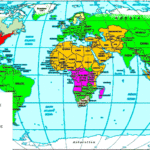Intro: many LGBT folks don’t think of Spain as a frontrunner in the gay rights movement but they are greatly mistaken. In June of 2005 the Spanish government approved full marriage rights for homosexual couples, becoming only the third country in the world to offer that status. But far beyond this one statuary change is a thriving and extensive national network of les-bi-gay life and activism that spans the mountains and plains of this very historic country, from far-out Ibiza Island through Barcelona, Madrid and on to the Costa del Sol.
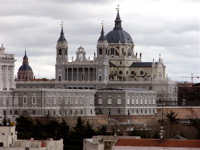
A Journey Through Spain
This is a journey through western civilization. Among the ragged mountains, dusty plains and storybook hilltop cities are the souvenirs and remnants of empires of vast distance and imagination. There were people in the Iberian peninsula for thousands of years before the Romans arrived with horses, shields and brilliant engineers who raised up huge coliseums and amphitheaters seating 40,000 people. Visigoths, Muslims, Christian knights, modern civil wars and a dictator followed by a reborn monarchy and democracy. It’s all packed into Spain from the Atlantic to the Mediterranean.
And of course among the invaders, winners and losers were countless gay and lesbian peasants, knaves, knights, bishops, kings and real queens with fabulous crowns who kept silent vigil over their secret desires for queer love, sex and passion.
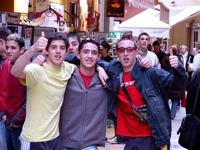 But silence has given way over a thousand years to clear and persuasive voices that sound out today in modern Spain, in major inland cities and along the high rise resorts of the south coast. Today’s Spain is a vacation haven for countless northerners in search of winter and spring sun, including thousands of LGBT folks who have made Ibiza, Sitges or Torremolinos their second home. So history continues to unfold in Spain as another ‘invasion’ of queer adventurers, lovers and sun seekers touch down on the shores of this ancient kingdom.
But silence has given way over a thousand years to clear and persuasive voices that sound out today in modern Spain, in major inland cities and along the high rise resorts of the south coast. Today’s Spain is a vacation haven for countless northerners in search of winter and spring sun, including thousands of LGBT folks who have made Ibiza, Sitges or Torremolinos their second home. So history continues to unfold in Spain as another ‘invasion’ of queer adventurers, lovers and sun seekers touch down on the shores of this ancient kingdom.
But more influential than tourists, Spain’s dedicated gay rights organizations have driven their cause deep into the heart of the government. Playing toreador to the government bull, the leading LGBT activist organization, FELGT, finessed, cajoled and persuaded the federal government, with complete success, to approve gay marriage in June 2005, the third European country to do so (after Holland and Belgium). For in depth reports about this historic legislation go to Gay Spain News & Reports 2005.
Madrid: Barrio de Chueca
A short evening walkabout in the Chueca district of Madrid, just north of the Prado Museum, is enough to see the heart core of LGBT life in Madrid: eating, shopping, sex, sleeping and soccer, books and pubs, dancing and talking.
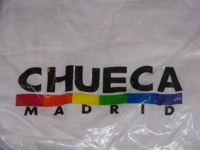 This is the ‘red zone’ of Madrid where trend and trash blend into a homey, bustling warren of small streets offering gay saunas, peep-shows, ‘naturist’ bars (clothing checked at the door), fashion shops sporting Dolce and Gabana underwear, chic slick cafes, old world pubs with sofas and ceiling frescos, a couple of rainbow bookstores, Madrid’s LGBT Center (COGAM), Starbucks and still more clothing shops. A place where every other door leads to a bar/café/pub with arrays of tempting ‘tapas’ snacks (including tripe) on the counters, Turks offer up kabobs and falafel in small bustling shops next to late night restaurants (dinnertime goes from 8 to 11 PM) where the waiter may take your order between televised soccer plays.
This is the ‘red zone’ of Madrid where trend and trash blend into a homey, bustling warren of small streets offering gay saunas, peep-shows, ‘naturist’ bars (clothing checked at the door), fashion shops sporting Dolce and Gabana underwear, chic slick cafes, old world pubs with sofas and ceiling frescos, a couple of rainbow bookstores, Madrid’s LGBT Center (COGAM), Starbucks and still more clothing shops. A place where every other door leads to a bar/café/pub with arrays of tempting ‘tapas’ snacks (including tripe) on the counters, Turks offer up kabobs and falafel in small bustling shops next to late night restaurants (dinnertime goes from 8 to 11 PM) where the waiter may take your order between televised soccer plays.
An American in Chueca
Not surprisingly, many foreigners fall in love with Spain’s charm, pace, culture and gay life. One such ‘victim’ is Lawrence Schimel, (pictured left), an award winning New York-born writer. Schimel has lived in Spain for six years and is proud of his fluent acquired second language. At the young age of 33 his name is on the cover of nearly 70 books and periodicals. A night owl he is often still at his computer at 5 AM hammering out fiction, poetry, children’s stories, magazine narratives or collating anthologies or creating adult erotica.
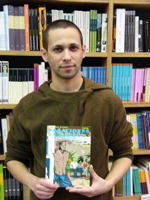 We met at Berkana one evening as we both were checking out the new arrivals—books, that is. Owner Mili connected us as I finished up interviewing her about Berkana’s unique history. Lawrence showed me several of his books, including gay comic books and a children’s book (in Spanish) on display.
We met at Berkana one evening as we both were checking out the new arrivals—books, that is. Owner Mili connected us as I finished up interviewing her about Berkana’s unique history. Lawrence showed me several of his books, including gay comic books and a children’s book (in Spanish) on display.
But soon it was closing time so we continued at the trendy D’Mystic Café around the corner where gay and straight couples and friends lingered over late night espressos. No surprise, Lawrence had much to say about his experiences as an expat gay writer in Spain.
“As has happened in many other gay neighborhoods, such as San
Francisco’s Castro, West Hollywood, or New York’s Chelsea, Chueca is now highly desirable real estate, also attracting liberal heterosexuals both as residents and as consumers of chic boutiques, eclectic restaurants, and vibrant nightlife. The free gay map of Madrid put out by Spain’s oldest gay and lesbian bookshop Berkana, has more than 130 listings of establishments of all sorts, bars, discos, cafés, shops, collectives and more. While many of these businesses are concentrated in Chueca, there are still the old fruit markets, typewriter-repair stores, and shoe showrooms that’ve always been here.” (Lawrence’s web site is http://www.circlet.com/schimel.html)
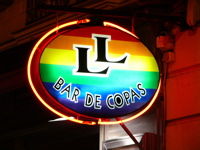 Indeed, Chueca displays the usual signs and symptoms of LGBT life: rainbow flags, underwear boutiques, posters for dances, scattered business cards on the sidewalks for a ‘naturist’ gay bar, MSM and WSW couples holding hands, men’s saunas, discarded issues of old issues of Shangay gay magazine, cafes with sit-down couples and klatches of guys or girls.
Indeed, Chueca displays the usual signs and symptoms of LGBT life: rainbow flags, underwear boutiques, posters for dances, scattered business cards on the sidewalks for a ‘naturist’ gay bar, MSM and WSW couples holding hands, men’s saunas, discarded issues of old issues of Shangay gay magazine, cafes with sit-down couples and klatches of guys or girls.
Walking down the main streets, Fuencarral and Hortaleza, on my first evening I saw a group of women with purple balloons and rainbow flags heading to a rally to hear speeches and music in celebration of International Women’s Day. This year Madrid’s organizing feminists included lesbians for the first time in their program. Needless to say it was an important step forward for them.
“ A revolution has happened here,” declared Mili Hernandez, co-owner with her lesbian partner of the well-stocked, high–energy and colorful Berkana bookstore-café-shop that offers thousands of books, clothes, sex toys, videos, household paraphernalia and good coffee with pastries.
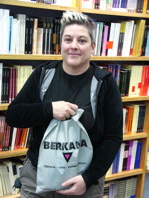 “Eleven years ago we opened our store and it was the only daytime gay place in the area. The area was then run down and filled with drug addicts. There were a few late night bars that hid in the dark, but we opened our doors in the daytime so gay people had a place to come,” adding that she has never had a single incident or problem with authorities. On her free bookmarks are listed Berkana’s offerings: books, magazines, videos, gifts and café. Mili also publishes books by LGBT authors.
“Eleven years ago we opened our store and it was the only daytime gay place in the area. The area was then run down and filled with drug addicts. There were a few late night bars that hid in the dark, but we opened our doors in the daytime so gay people had a place to come,” adding that she has never had a single incident or problem with authorities. On her free bookmarks are listed Berkana’s offerings: books, magazines, videos, gifts and café. Mili also publishes books by LGBT authors.
(See http://www.curvemag.com/Detailed/614.html for more details.)
Mili (left) is an outgoing, upbeat cheerful woman in her forties who presides over the busy store with the ease and confidence of a den mother while her quieter partner, Mar del Griñó, tends to the less hectic gift shop downstairs. At first glance, the soft spoken, straight-looking ‘auntie Mar’ seems out of place among some of the merchandise that includes dildos, condoms, harnesses and leathers chaps. But she takes it all in stride as if she were selling fruit or lollipops.
Along Calle de Fuencarral, at #37, is Madrid’s LGBT center named COGAM (Collective of Gays and Lesbians of Madrid). Open every day from 5-9 PM it is the heartbeat of gay Madrid where essential services are offered such as a phone help line counseling, political organizing, social organizing, and a safe-place café for hanging out with friends. It was busy the first time I visited with a lot of women gathering for the women’s rally. Here there are numerous free magazines and maps that list the dozens of LGBT venues, events and services in Madrid and across the country. On the bulletin boards are notices for meetings, clubs, sports, pets, roommates and other hook-ups.
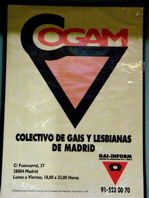 On the ground floor a friendly and chatty café serves coffee and teas and condoms with equal aplomb. Upstairs are a dozen offices of this well run organization. I met Ramon Nunez and Chema Luengo, two of the many volunteer staff who make COGAM function.
On the ground floor a friendly and chatty café serves coffee and teas and condoms with equal aplomb. Upstairs are a dozen offices of this well run organization. I met Ramon Nunez and Chema Luengo, two of the many volunteer staff who make COGAM function.
A quiet friendly man on his thirties with thick dark hair and rimless glasses, Ramon is an insurance adjuster by profession who works four hours a week to coordinate social services for COGAM. He listed an impressive menu of activities that take place each week. There are groups for parents of gays, gay parents, lesbians, gay Catholics, youth, another for all ages, for transgender folks; there’s a theatre/opera group, others for sports/hiking and human rights advocacy. A unique group is for deaf LGBT people. Then there’s the library, a weekly radio program and a web site (www.cogam.org). Psychological and legal counseling (supplied by the government) is offered for legal issues, unemployment, and human rights. Although there is no group for Muslims gays I did see health literature in Arabic offered.
For icing on the cake, COGAM is funded by the government of the Madrid province, as are other LGBT centers and services by different provincial governments around the country.
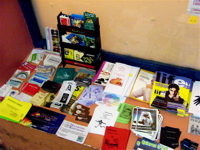 COGAM’s offices are also home to FELGT (Federation of Lesbians, Gays, Transsexuals and Bisexuals), Spain’s national umbrella LGBT political/activist organization (www.felgt.org) who are most visible with their advocacy programs for human rights, non-discrimination statutes and most recently for gay marriage. The latter appears headed for victory in June 2005 when the parliament is expected to vote in favor of full and equal marriage for all couples in Spain. (For some background news and reports on LGBT politics and activism see Spain News.)
COGAM’s offices are also home to FELGT (Federation of Lesbians, Gays, Transsexuals and Bisexuals), Spain’s national umbrella LGBT political/activist organization (www.felgt.org) who are most visible with their advocacy programs for human rights, non-discrimination statutes and most recently for gay marriage. The latter appears headed for victory in June 2005 when the parliament is expected to vote in favor of full and equal marriage for all couples in Spain. (For some background news and reports on LGBT politics and activism see Spain News.)
Modern History
At COGAM I also met Ramon Linaza, a former advocate and activist with FELGT who offered some time to further describe the history and achievements of FELGT in its long march from dictator Franco’s brutal repression (1936-75), when gays were jailed and tormented, to the abundance, dignity and pride of today’s gay Spain.
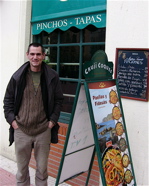 Ramon was born in 1957 and by the time he was 18 Franco was sputtering his last gasps. But that did not stop Ramon from being arrested for protesting against the regime: “since that time our progress has been phenomenal–except for a 1981 attempted military coup that failed quickly. The first gay rally against hated leftover Franco laws took place in Barcelona in 1977 and in Madrid in 1978; in 1979 the discriminatory laws were rescinded. In the 80’s a great ‘Movida’ (progressive movement) took place as freedom of expression and individuality increased.”
Ramon was born in 1957 and by the time he was 18 Franco was sputtering his last gasps. But that did not stop Ramon from being arrested for protesting against the regime: “since that time our progress has been phenomenal–except for a 1981 attempted military coup that failed quickly. The first gay rally against hated leftover Franco laws took place in Barcelona in 1977 and in Madrid in 1978; in 1979 the discriminatory laws were rescinded. In the 80’s a great ‘Movida’ (progressive movement) took place as freedom of expression and individuality increased.”
Ramon, a handsome man in his forties with chiseled features has been partnered with Carlos, an actor, for over 30 years. They rent a flat in one of Madrid’s countless apartment blocks in the middle class suburb area of Trafalgar. On December 1, 2005 (World AIDS Day) Ramon and Carlos got married in a public ceremony (“as a show of solidarity”) that was reported on TV, with many positive responses. Together they run a cafe theatre in Madrid named “Candilejas”.
Ramon has been HIV positive for nearly 20 years. For him HIV is a manageable disease due to the miracle of modern ‘cocktail’ antivirals and a generous government health system. “My medicines cost about 3000 euros a month but it’s all paid by our social system of medicine.”
Ramon observed that the gains of the LGBT community have been due to many factors such as an abiding reaction against Franco’s fascism in favor of democratic rights, joining the EU with its pro-gay statutes, a greatly diminished Catholic church and the current European and Canadian groundswell for gay marriage rights. These have all clearly been felt here.
Further aiding the development of gay rights, Lawrence Schimel has also observed that a certain indifference toward political or relgious activism emerges from the ‘common folk’. There is little fervent anti-gay fundamentalism in the streets or in the media. “This Spanish apathy fortunately also afflicts Spain’s homophobes, and the active hate-mongering along the lines of the U.S.ˆs Christian right is largely absent.
“Perhaps this lack of an organized visible enemy, the general lack of urgency, combined with the Mediterranean character of live and let live, inhibits a sense of personal political identity and activism as we are familiar with in the States. Able to hold one’s boyfriend’s hand in public, and with various openly-gay actors, writers, dancers, and other role models in daily view, many Spanish queers lack the personal incentive to fight for legal reparation of homosexuals.”
(Schimel also noted that this lack of “social conscience” cuts both ways as some LGBT activist organizations have seen a drop in volunteerism in the recent years. He quotes Mili Hernández, the owner Berkana bookstore in Chuec who has spoken about this constriction of a gay voice: “We’re living in a state of tolerance in Spain that’s only virtual, which allows us to display our sentiments as in public without problems, in Chueca. But we’re still missing that true tolerance that would let us live openly as gays and lesbians in rural areas and the smaller towns.” )
Crowning this movement, Ramon happily described the highly visible and recent appointment of Pedro Zerolo, an openly gay Madrid city council member and former president of FELGT, as a member of the ruling Socialist party’s executive committee, one of Spain’s most influential positions. Zerolo now oversees social movements and policies regarding issues of race, gender, sexuality, age and religion. (For a more detailed report about Zerolo, see Spain News, #22.)
The Socialists were swept into power in 2004 in reaction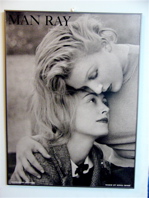 to the terrorist bombing at Madrid’s huge Atocha train station that killed hundreds of people, presumed in response to Spain’s support for the US led war in Iraq. Immediately upon his election the new Prime Minister Zapatero withdrew Spanish troops from Iraq to the cheers of most Spaniards.
to the terrorist bombing at Madrid’s huge Atocha train station that killed hundreds of people, presumed in response to Spain’s support for the US led war in Iraq. Immediately upon his election the new Prime Minister Zapatero withdrew Spanish troops from Iraq to the cheers of most Spaniards.
Make no mistake about gay Spain being on the forefront of LGBT rights in Europe. Madrid, in addition to other leading LGBT cities such as Barcelona, Valencia and Malaga, is a beaming landmark along the out and proud LGBT trail across Europe that reaches from Costa del Sol on Spain’s Mediterranean coast across the continent through Zurich, Budapest to Warsaw to Berlin to Amsterdam on up to London and Manchester and over to Oslo. It is one of the strongest, most articulate and advanced arcs of gay human rights in the world today.
Play Time
Chueca is a neighborhood where friends live and play and tell silly sad tales of romance, family dramas and urgent gossip. The usual greeting is a kiss on either cheek or maybe both if one is special. Whether sitting with peers with pierced lips and spiky hair or doing Saturday chores Lawrence Sxhimel notes that sometimes it’s hard to get from one end of Checa to another especially if accompanied by a outgoing friend who seems to know everyone. Kisses and hugs, schmoozing tid bits of never-ending emotion, comparing new shoes–not to mention exchanging glances with new faces from the gym or a new waiter from D’Mystic Café. “Such immediacy can be a dazzle” as the poet Rilke said of another place and time.
The nightlife that takes over Chueca and many other districts after 9 PM. Dinner here starts about then and can go on till midnight when the clubs, bars, discos, saunas warm up as the younger generations dress up or down to attend their favorite haunt.
My first introduction to the ‘scene’ was through Matt, a handsome visiting Brit, in his thirties with cheerful lively dark eyes, short dark hair and a youthful face. In an unpretentious and open manner he described the delights of the restaurants, museums, clubs and all-night saunas. In Madrid to let his hair down he has danced, dined and dipped into some sex at the various opportunities available to locals and visitors in this sleepless megopolis of three million people. He was recovering from an all-nighter when we met.
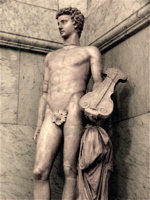 “ What did you do all night,” I asked, since I can’t remember when I had done the same. “Well, dinner of course doesn’t start before ten and then it’s midnight. I met the British owner of Liquid bar and we talked for a while and he wanted me to come back at three. So I went to the Paraiso sauna for two or three hours and met this really cute guy I played with till his catty friends found us and interrupted with unkind remarks. So that fell apart and I left to go back to Liquid and meet this other guy. We went out for some food and another disco at four. Then to bed at six. Six o’clock! I couldn’t believe I was doing that. I’m thirty. I’m too old for this!”
“ What did you do all night,” I asked, since I can’t remember when I had done the same. “Well, dinner of course doesn’t start before ten and then it’s midnight. I met the British owner of Liquid bar and we talked for a while and he wanted me to come back at three. So I went to the Paraiso sauna for two or three hours and met this really cute guy I played with till his catty friends found us and interrupted with unkind remarks. So that fell apart and I left to go back to Liquid and meet this other guy. We went out for some food and another disco at four. Then to bed at six. Six o’clock! I couldn’t believe I was doing that. I’m thirty. I’m too old for this!”
But apparently not for many young locals. Schimel, in six years of adapting to his new home has seen how the locals survive such intense action: “Spaniards have this knack of what I call “dormiendo de prisa” (“sleeping very quickly”), able to compress an eight-hour night’s sleep into only three or four and still function, a Spanish trait I’ve still not managed to assimilate after these years.”
So the scene is what you want it to be—as in any big metropolis with a lively scene—gay or straight. The queers are not the only night prowlers. Along the streets of Chueca I spotted (and was spotted by) various ladies coming on their night shift in skimpy tight outfits and high heels.
Magazines for LGBT Community
To organize a visit to gay Madrid or Barcelona or any other major city a visitor must pick up one of the free glossy magazines that listed venues across the country. The most visible is Shangay, a free scene-zine with the latest in fashion, disco happenings, parties, theatre and musicals, phone sex and soft porn underwear. Shangay also offers Shanguide to the LGBT scene in Madrid with many listings of the current scene from sex to cinema, from books to pet adoptions, music and dining.
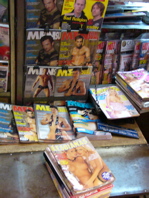 Another major magazine is Zero (costs 4 euros) that comes with Zero-guia (guide) that also lists nation-wide venues. This large format glossy offers feature stories (such as sex for sale and gays in Nepal) book reviews, ads for upcoming cultural and social festivals as well as the usual countless ads for clubs, CDs, videos reviews, fashions, food and real estate. The issue I bought came with a complementary magazine called Zero Decora, another hundred-page glossy focused on fashions and interior design sporting male models with perfect abs lounging about in bikinis.
Another major magazine is Zero (costs 4 euros) that comes with Zero-guia (guide) that also lists nation-wide venues. This large format glossy offers feature stories (such as sex for sale and gays in Nepal) book reviews, ads for upcoming cultural and social festivals as well as the usual countless ads for clubs, CDs, videos reviews, fashions, food and real estate. The issue I bought came with a complementary magazine called Zero Decora, another hundred-page glossy focused on fashions and interior design sporting male models with perfect abs lounging about in bikinis.
A much smaller (32 pages) guide is Todosexo which I found to be unusual in that nine of its full-page ads were for lesbian hook-ups or phone-sex, something I had not seen before in any scene magazine before.
Odisea is another glossy monthly with much the same ads, features, erotic photos, happenings, news, play reviews, nation-wide listings and a full page ad promoting Madrid as a candidate city for the 2012 Olympics.
At Berkana bookstore I found copies of a large-format ‘Gesto—The Other Magazine’ a more upscale and stylish monthly featuring more thoughtful essays on lesbian parenting, art history , Islam and homosexuality, the solitariness of phone sex, film making and haute nude photography, etc. However, I don’t think it’s still published since the issues I saw were free and out of date.
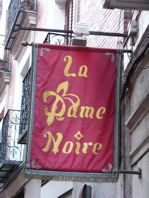 After dark the velocity slows down to a convivial pace as singles, couples and groups of lesbigays gather for a drink or a ‘menu del dia’ dinner at the cafes and restaurants woven into the narrow alleys and streets with catchy names such as My Way, La Dame Noire, Gula Gula, Mama Ines and Tia Dolly. Usually, after strolling the ‘scene’ I settled on a place such as Restaurant Vivares and ordered my ‘cena’—often it was about 10 PM. (It pays to carry early evening snacks when traveling around Spain.)
After dark the velocity slows down to a convivial pace as singles, couples and groups of lesbigays gather for a drink or a ‘menu del dia’ dinner at the cafes and restaurants woven into the narrow alleys and streets with catchy names such as My Way, La Dame Noire, Gula Gula, Mama Ines and Tia Dolly. Usually, after strolling the ‘scene’ I settled on a place such as Restaurant Vivares and ordered my ‘cena’—often it was about 10 PM. (It pays to carry early evening snacks when traveling around Spain.)
In all, Zero guide lists more than 100 LGBT venues in Madrid, including cafes, bars, restaurants, saunas, a dozen sex shops, and discos as well as numerous gay travel agencies, hairdressers and dozens of gay or pro-gay clothing stores.
Beyond Madrid
Although Madrid has Spain’s largest LGBT community this city is hardly alone in offering a rich choice of community, entertainment and social life. I didn’t make it to Barcelona this time. Just covering the southwest quarter of Spain, as I did with a rental car, easily consumed three weeks.
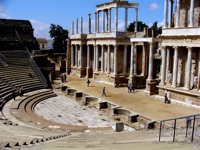 My route included Madrid, Toledo, Cordoba, Granada, over the mountains to coastal Malaga, Marbella, Torremolinos, Gibraltar (UK), Huelva area (to see the little town of Palos de la Frontera where Columbus set sail) then up to Seville, on to Merida with its great Roman coliseum and amphitheater, then to Segovia and its awe-inspiring Roman aqueduct and finally Trujillo where the explorer Pizarro originated.
My route included Madrid, Toledo, Cordoba, Granada, over the mountains to coastal Malaga, Marbella, Torremolinos, Gibraltar (UK), Huelva area (to see the little town of Palos de la Frontera where Columbus set sail) then up to Seville, on to Merida with its great Roman coliseum and amphitheater, then to Segovia and its awe-inspiring Roman aqueduct and finally Trujillo where the explorer Pizarro originated.
There is so much ancient history in Spain in addition to an abundance of modern life. Barcelona, with a population of more than 1.5 million people—half the size of Madrid—offers about half the LGBT venues and businesses, which is still a considerable number: 50 bars and cafes, 15 discos, 8 saunas, 45 restaurants as well as other similar services as Madrid including the activist FELGT organization. (That’s a separate story, coming soon.)
Although not known internationally as a gay destination, Malaga city on the southern Mediterranean coast with a population of nearly 600,000 has Spain fifth largest (Valencia is third, Seville is fourth) year-round gay population. Here I found LGBT activist organizations offering social, political, legal and educational services.
I spoke to leaders of the two groups in Malaga, COLEGAS and OJALA. Although they overlap with some of their services they don’t work together, each operating with their own volunteers and staff.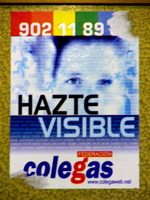
COLEGAS (Collectivo of lesbianas y gays), with offices on Victoria Street in the heart of the historic district that includes Malaga’s immense cathedral, is the larger of the two associations (www.colegaweb.net). With branches in the cities of Almeria, Granada, Jaen, Huelva, Cordoba, Madrid, Valencia, Burgos and Seville COLEGAS offers up a menu of weekly social and cultural services that are summarized in their monthly magazine Colega. (COLEGAS is not a member of FELGT, the nationwide umbrella organization in Madrid. FELGT has about 32 inclusive LGBT organizations under it auspices.)
COLEGAS provides social and educational services. Volunteer Santiago Rubio told me their work is provides outreach to secular institutions such as police, universities and schools. When I visited there was a training being given to several volunteers to prepare them for an upcoming radio program that would be aired in Malaga in the near future. They also provide support groups for the LGBT community including and psychological support to young people facing adjustment problems such as coming out and self esteem.
COLEGAS has a monthly magazine Colega with feature articles on such topics as immigration, health, human rights and legal rights. Colega magazine reviews the organization’s monthly activities and provides world-wide news, books reviews, film reviews and entertainment ads.
There is another LGBT magazine in Malaga called Malagay (www.malagay.com, www.costagay.com) that comes out monthly,. It also has feature articles such as Islam and homosexuality, gay life in Africa and South America, HIV, interviews with gay leaders as well as listings for LGBT events.
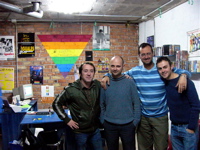 Malaga’s second LGBT organization is OJALA, a smaller association that focuses on human rights, outreach education and has a phone help line (www.ojalamalaga.com) Two helpful volunteers, Marco Barquero and David Aránega, met with me in their downtown office and described Ojala’s social and educational services.
Malaga’s second LGBT organization is OJALA, a smaller association that focuses on human rights, outreach education and has a phone help line (www.ojalamalaga.com) Two helpful volunteers, Marco Barquero and David Aránega, met with me in their downtown office and described Ojala’s social and educational services.
One of OJALA’s best known members is Antonio Gutierrez Dorado, 53, one of Spain’s earliest activist who launched protests against the Franco regime and advocating for the removal of the pernicious anti-gay laws. Gutierrez is now vice president of ‘Association of (homosexual) Ex-prisoners’ (under Franco) within the Democratic Union of Homosexuals (founded in 1975, the first gay rights organization in Spain). The efforts of this group are currently aimed at destroying all police and psychiatric records of imprisoned gays and demanding compensation for past discriminatory and arbitrary imprisonment and punishment. (Happily, the government approved the compensation in 2004.)
Antonio Gutierrez was among the first, in 1976, to denounce the treatment of gays in Spain. He demanded freedom for political and sexual prisoners and abolishment of the hated ‘ley de peligrosidad social’ (the social danger law that authorized the arrest of ‘socially undesirable’ people. (It was abolished in 1979.) He also demanded social equality for all. However, to this day, despite knowing which judges, police and military officers were responsible for unfairly imprisoning gays and other minorities no one has been accused or indicted. Gutierrez doesn’t want revenge but rather accountability and acknowledgement of wrongdoing.
Hot Spots
Gay life in Spain is alive and well beyond the major cities. It would take a year of careful travel to research all the gay venues listed in Shangay magazine and Zero-guia (guide). I counted about 40 cities across Spain with LGBT listings–not bad for a country only thirty years beyond Franco.
Many gay visitors to Spain think first of Torremolinos and Ibiza as the gay hot spots of the country. I passed through Torremolinos 25 years ago before the gay invasion.
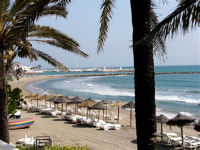 Today the city is densely crowded with mostly straight sun seekers from northern Europe. High-rise hotels crowd in among endless blocks of holiday flats. I wondered who would want to spend a holiday here among the swollen traffic, shopping congestion, fast food joints and masses of straight Brits and Swedes. Then I went to the beach and my objections dissolved.
Today the city is densely crowded with mostly straight sun seekers from northern Europe. High-rise hotels crowd in among endless blocks of holiday flats. I wondered who would want to spend a holiday here among the swollen traffic, shopping congestion, fast food joints and masses of straight Brits and Swedes. Then I went to the beach and my objections dissolved.
Miles of sand stretch out along the Mediterranean under clear blue skies with the warming sun of spring chasing off the chill of late winter. Just looking out across the gentle sea has a soothing effect. One can walk along the light brown sandy beaches for miles picking up colorful seashells. There are also plenty of laid back restaurants along the shore road serving heart-stopping English breakfast–eggs, sausage, ham, chips/fries, beans and toast!
As I checked e-mail one day (mid March) in Torremolinos where the temp was about 70 degrees (F), a friend wrote to me from Oslo and mentioned it was 15 degrees (F). This also helped explain the popularity of this south coast city.
There are (perhaps exaggerating slightly) millions of condos and flats and houses built here—and more in the making– along this area of the sea, many are second holiday homes and many are being bought by retirees from France, Germany and the UK. Other folks come here on holiday package tours such as the pleasant husband and wife duo we met from Dublin who were part of a group of 700 Irish folks in Costa de Sol for a week of Irish music. Their airfare, four-star hotel, two meals a day and the concerts cost them less than a thousand dollars each. A very good deal.
For LGBT visitors Torremolinos is a combination of Brighton Beach (UK) and South Beach (USA)–warm and playful. There are now about 40 gay bars and cafes, half a dozen discos including the huge Palladium, two dozen gay owned/friendly restaurants and some sex shops. Not bad for a city of about 36,000 residents—that swells to over a hundred thousand in the high season.
I didn’t go to Ibiza on this trip but the little island with the big gay heart has about the same number of LGBT venues as Torremolinos. The year-round population of the island is just under 100,000 but swells to accommodate a million visitors a year. Ibiza City (Eivissa) is the focal point of LGBT night socializing where the majority of venues can be found and arguably the best gay beaches in Spain.
Valencia
The east coast city of Valcenia, on the Mediterranean is not commonly thought of as a gay destination but this city of 750,000 is a very lively city. I didn’t go to Valencia on this trip but in one of his essays, Schimel has written: “Valencia is the focus of attraction for thousands of gays and lesbians,” quoting Ximo Cádiz, coordinator of Valencia’s Col.lectiu Lambda, “who live, for the large part still in the closet, in the smaller towns and villages of the region, and who find in our city a space of freedom.” The Col.lectiu Lambda is a volunteer-run gay center, providing a mix of counseling and legal services to its members, as well as agitating and campaigning for legal and social reforms. It also provides a locus for socializing, with a women’s group, a youth group, a group for seropositives, and more. It is perhaps one of the most efficient of the many gay collectives scattered throughout the country, which over the past few years has begun to work together under the umbrella organization FELGT in Madrid to put on events. Valencia’s gay pride celebration now draws about 4,000 people.”
Sevilla
In the ancient and picturesque city of Sevilla, with a population of over 700,000, there is a large selection of LGBT venues and organizations. Both Zero-guide and Colega magazines list about 25 gay bars and cafes as well as numerous discos, restaurants, saunas, hairdressers and clothing stores. It is Spain’s fourth largest ‘gay city’, after Madrid, Barcelona and Valencia. The main LGBT social is a branch of the COLEGAS organization based in Malaga. 
There is also a little gay guest house on a street narrow enough for two bicycles to pass. Airesvilla gay guest house (http://www.airesevilla.com/english.html) doesn’t even have a street number. The street is about a hundred and fifty feet long and about five feet wide. The guest house is narrow, three stories tall with six rooms (costing about 90 euros for a double). You can’t miss it–after you find the street in the maze of alleys and passages of the old town! It’s virtually next door to a recently re-opened Arab Bathhouse (a trendy upscale non-gay spa). Airesvilla’s tasteful minimal décor is the effect of its handsome owner, Fabian Perez, originally from Argentina, who was busy sorting linens as we talked.
Fabian recently opened Naranja restaurant. As you might expect from a decorator queen, it’s quite different from the old world look of Seville. The restaurant is modern, upscale, chic and a bit expensive but the food looks as fab as it is delicious.
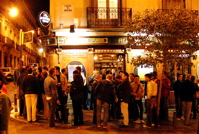 The ‘gay barrio’ of Seville is mostly but not exclusively in and near the Alameda de Hercules Plaza, a six-block-long park lined on both sides and ends with one café or bar after another. There are about a dozen LGBT venues mixed in with a couple dozen non-LGBT places. Needless to say the whole area becomes quite popular after work and on weekends. Hundreds of people mill around inside and outside the cafes drinking and snacking on tapas.
The ‘gay barrio’ of Seville is mostly but not exclusively in and near the Alameda de Hercules Plaza, a six-block-long park lined on both sides and ends with one café or bar after another. There are about a dozen LGBT venues mixed in with a couple dozen non-LGBT places. Needless to say the whole area becomes quite popular after work and on weekends. Hundreds of people mill around inside and outside the cafes drinking and snacking on tapas.
A stroll through the area late afternoon is a lesson in high sociability, camaraderie, drinking, laughing and some youthful sloppy behavior. The gay venues are closely packed in with the straight ones so it’s impossible to tell who in the crowd is patronizing which pub. Central Café is directly across a small street from Habanilla Café. Hercules bar is a stone’s throw from El Hombre y el Oso (The Man and the Bear) bar which is across the street from Men to Men disco.
Usually the bars, such as Men to Men, El Hombre y el Oso don’t start warming up until midnight or later, staying open till four or six AM. El Hombre y el Oso has three floors with a dark room on the top floor for naughty boys. Behind the bar, tended by the hefty owner, is a collection of toy bears.
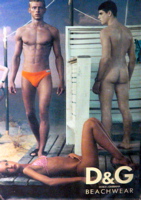 Around another corner are El Baron Rampante and El Bosque Animado cafés hosting early evening overflow crowds. These popular pub/cafes are mixed gay and straight.
Around another corner are El Baron Rampante and El Bosque Animado cafés hosting early evening overflow crowds. These popular pub/cafes are mixed gay and straight.
What was so comfortable about these places was the easy unrivaled ambience the patrons appeared to enjoy. Some were crowded at the bar with their drinks, others at small stand-up tables eating tapas and many were standing outside holding their glasses of (mostly) beer talking in pairs or small congenial groups, some obviously gay or lesbian others mixed and jovial.
There is nothing remarkable to say about these kinds of places because they strike me as so natural and unperturbed; people are simply open to being with friends and acquaintances or like-minded strangers where smiles and accepting eyes are the norm.
Semana Santa (Easter Week) in Sevilla
As luck would have it, I arrived in Spain a couple of days before the Easter Holy Week which is Spain’s biggest religious/social festival/party. There is no more immediate introduction to the Spanish addiction to fiestas than being in a crowd of thousands along the winding cobblestone streets of Seville to see the parades and costumes.
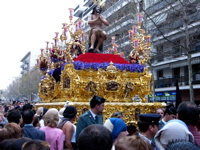 In this case one picture is clearly worth more than a thousand words and I leave it to my photo gallery to depict this secular pageant of statues, crosses, incense burners, ornate silver plated candle holders, religious costumes, bands playing plaintive tunes, tears for some, dress-up clothes for most, lots of drinking, hanging out with friends, estrogen girls and testosterone boys cruising one another, mounds of chips and tapas, sore feet, baby carriages—and very slow moving floats (pasos).
In this case one picture is clearly worth more than a thousand words and I leave it to my photo gallery to depict this secular pageant of statues, crosses, incense burners, ornate silver plated candle holders, religious costumes, bands playing plaintive tunes, tears for some, dress-up clothes for most, lots of drinking, hanging out with friends, estrogen girls and testosterone boys cruising one another, mounds of chips and tapas, sore feet, baby carriages—and very slow moving floats (pasos).
Each procession carries two floats, one with Jesus in different scenes of suffering and one with Mary dressed up like a bride and surrounded with candles. Seville has numerous processions each day of Holy Week. The heavy floats (weighing more than a thousand pounds (500 kilos) are borne on the shoulders and backs of thirty hefty men (costaleros) and accompanied by hundreds of hooded parishoners in Ku Klux Klan drag as they weave different routes through the city. However, all the processions pass through the huge cathedral, in silence.
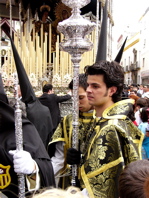 Much media hype is made of the religious impact and devotion during the Holy Week. I must admit to a few brief moments of thrill when the floats were heaved up onto the shoulders of the carriers causing the statues began to sway in a slow rhythmic motion. The normally stiff painted figures of Jesus and Mary seem to come alive for a moment as each float moved in the night lights amid flickering candles accompanied by doleful music of the bands and touched by easy breezes that fluttered the costumes.
Much media hype is made of the religious impact and devotion during the Holy Week. I must admit to a few brief moments of thrill when the floats were heaved up onto the shoulders of the carriers causing the statues began to sway in a slow rhythmic motion. The normally stiff painted figures of Jesus and Mary seem to come alive for a moment as each float moved in the night lights amid flickering candles accompanied by doleful music of the bands and touched by easy breezes that fluttered the costumes.
Nevertheless, I was told later the actual impact of Semana Santa on most citizens is minimal, like Sunday church going. For most this was a party week with time off from work or a chance to get outof town.
Thousands view this religious festival live or on TV but thousands also ignore it by staying home or going to a favorite café, pub or bar. Later, about eleven thirty at night the city looks as if it’s five o’clock rush hour with packed restaurants, cafes and bars as spectators crowd the food venues in search of eats after waiting and standing for three or four hours–leaving the streets very littered with trash that’s quickly swept up by hundreds of city sanitation workers in bright green outfits.
No doubt LGBT folks are among the thrilled onlookers and devout torchbearers as well as among the indifferent populace who have seen it all before and prefer a café night out with friends or anonymous visit to a sauna.
Finally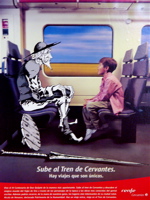
Gay Spain has come a great distance in just thirty years from a rude and repressed past to the forefront of gay/human rights with imminent marriage rights. It’s a remarkably fortunate turn of Spanish history that gay activists spoke up and were heard by progressive political leaders starting in 1979. Today no LGBT person need live in fear or shame. If he or she comes from an unfriendly environment there are many choices now–including full marriage rights–to live in the light of gay pride and equality.
By Richard Ammon
Revised July 2010
Also see:
Gay Spain News & Reports 2000 to present
Spain Photo Galleries

